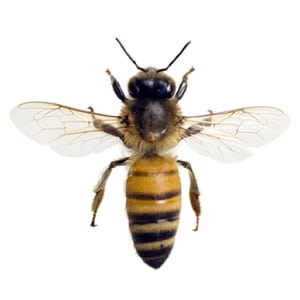Pest Control Services For Honey Bee Hive Removal In India
Bees, wasps control & bee hive removal services in Mumbai, Delhi NCR, Kolkata, India. At Easycare we provide best pest control services which helps you get rid of honey bees and bee-hives near your house & surroundings.

Social Wasps
Family – Vespidae.Yellow and black abdomen. Markings will differ according to species.
- 3/4 – 1 inch long.
- Female faces are black, male faces are yellow.
- Thorax has bright yellow, orange or white hair on it.
- No traces of hair can be found on the abdomen.
- Females have a stinger, males do not.
- Young Queens overwinter and emerge in the spring to start nest building and lay eggs.
- Workers (sterile females) emerge during early summer and take over nest building. Queen continues to lay eggs.
- Mating happens in the early autumn time of the year.
- Nest dies during winter, including all the males and workers. Only Queens survive to the next year.
- Size of the colony —can be from medium to large (up to 25,000 individuals).
- Preferred nest sites — lofts, wall cavities, old rodent holes, hollow trees.
- Nest construction — A new nest is produced each year with pulped wood (paper) and combs are set horizontally.
- Swarming — does not swarm.
- Food preferences — will take insects and sweet foods.
- Stings readily and repeatedly.
Carpenter Bee: Xylocopavirginica:
- 3/4 – 1 inch long.
- Female faces are black, male faces are yellow.
- Thorax shows traces of bright yellow, orange or white hair.
- No hair on abdomen.
- Females have a stinger, males do not.

- Prepare a tunnel into wood to lay eggs.
- It takes 7 weeks approx. for the lifecycle from egg – larva – pupa – adult.
- Larva is large and noisy.
- New adults emerge from the nest late August.
- They only sting when provoked.
- They are visible during the late-spring to mid-October.
- They prefer to nest in untreated softwoods, redwood, cedar, cypress, and pine. They reuse the old nests.
- Their nests can be found in eaves, window trims, facia boards, siding, decks and outdoor furniture.
- They feed on flowers that contain pollen, egBradfords, Daffodils, Pansies. Pollen stored in abandoned tunnels for overwintering.

Hornets: Vespa crabro
- Large, up to 1.8 inches long.
- The colour of the wings is reddish-orange.
- Their abdomen is orange and brown stripes.
- Nests are founded in the Spring. Build nests in the spring.
- Most die-off by late Autumn.
- Only the fertilized Queen hibernates.
- They build nests in sheltered places like tree trunks, bushes, building sides, barns, hollow walls. They are grey in colour and paper-like.
- A colony can reach a size of 700 workers
- They only sting when provoked. It is quite painful for humans. They can mobile the entire nest to stings to defend themselves and this can be very dangerous for humans.
- They feed on insects and saps. They are not seen near human food.
Honey Bee: Apismellifera
They are dark brown in colour and body is covered with hair.
- 3/4 – 1 inch long.
- Female faces are black, male faces are yellow.
- Bright yellow, orange or white hairs on the thorax.
- There is no hair on the abdomen.
- Females have a stinger, males do not.

- Usually the colony size is large and there are more than 30,000 bees in colony.
- They prefer to build nest on hollow trees, roofs, and wall cracks.
- The nest is constructed with wax combs which hangs vertically and they use it constantly throughout the life of the colony.
- They swarm in Spring and early Summer.
- The whole colony overwinters.
- They only feed on honey and pollens.
- Will not sting unless provoked.

Solitary Bee: Apismellifera
They are mostly similar to honey bee.
- 3/4 – 1 inch long. They are 3/4 to 1-inch long.
- Females have black faces and males have yellow like others.
- The thorax is filled with bright yellow, orange or white hair.
- There is no hair on the abdomen.
- Only females can sting.
- They have small colonies which are tended by a female.
- Soil, soft cement, and mortar between bricks are some locations where they build nests.
- Each year they build a new nest using various materials.
- They do not swarm.
- They overwinter usually in the pupal stage within the nest.
- They feed on honey and pollen only.
- They rarely sting.
